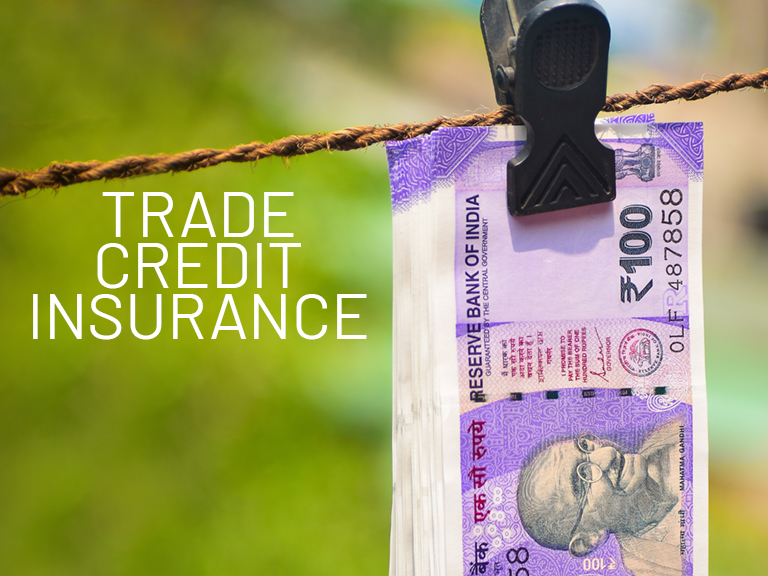M/S Mohd. Usman Sugar Ltd. Saharanpur (UP) had exported a consignment of Sugar valued at Rs 4.5Crs. on 28th May 2021 on credit to a leading buyer in Kandahar (Afghanistan) and as per sales terms the remittance from the buyer was expected to be paid in early July 2021. However, in the meantime the Taliban militia started taking control of Afghanistan, almost 20 years after being ousted by a US-led military coalition. Mr Usman has been in business with the buyer in Kandahar for the last 15 years and there had been no incidence of default/delay but unfortunately this time payment is nowhere in sight, whereabouts of buyer are also not known, and Mr Usman feels ruined. Unfortunately, Mr Usman had not taken any insurance cover like Credit Insurance cover to protect the credit default.
There have been many other cases wherein remittances were delayed /not received/ partially received after lockdown was declared in many countries globally due to outbreak of Covid pandemic in 2020 and exporters across the world suffered massive losses due to non-payment/ delayed payment just because trade credit was not protected.
What is Trade Credit – Trade credit is a two-way business transaction between a supplier and a buyer wherein a buyer buys goods and/or services on account without making immediate cash or cheque payments. Trade credit thus allows buyers to receive goods or services in exchange for a promise to pay the supplier within a set amount of time. Usually, the supplier gives the buyer 30, 60 or 90 days to pay. In some cases, certain buyers may be able to negotiate longer trade credit repayment terms, which provides an even greater advantage.
New businesses often have trouble in securing finances from traditional lenders, but a buyer gets the goods up front without handing over any cash and thus trade credit helps increase their purchasing power.
Advantages of Trade Credit to Seller/buyer– Trade credit is an advantage for a buyer because it is thought of as a type of 0% financing, increasing a company’s assets while deferring payment for a specified value of goods or services to sometime in the future and requiring no interest to be paid in relation to the repayment period.
Trade credit is also of benefit to seller because he is able to sell the goods and services to buyers in emerging and new markets who are financially constrained, and seller has the advantage of creating new markets for his goods and services in unpenetrated territories.
Commercial and Political Risks of Trade Credit to Seller -Sellers are usually at a disadvantage with a trade credit as they have sold goods, but there is always a risk of non-payment / delayed payment which may occur due to Commercial (in the case of export trade) or Political risks. The commercial risks are – reasons beyond the control of buyer, insolvency and extended late payment – the failure to pay within a set number of days of the due date. Extended late payment constitutes protracted default.
Political risks involve n o n – payment on an export contract or project due to actions by an importer’s local government. These may include intervention to prevent the transfer of money or such as buyer’s insolvency, protracted default, political events, or acts of war that prevent contract performance etc.
Non-receipt of export proceeds in India may attract penal action besides payment of interest, penalty etc. as per provisions of Foreign Exchange Management Act 1999.
What is Trade Credit Insurance- Therefore, when a Seller supplies goods or services to other companies on credit terms, there is a need to minimize the credit risk associated with non-payment or delayed payment. A comprehensive Trade Credit insurance policy is an effective financial Risk Managementtool that compensate a policy holder when their clients fail to pay for goods and services. By covering this risk, Credit Insurers enable Sellers to extend credit more liberally and ensures improvement of bottom-line quality, increase profits, and reduce risks of unforeseen customer insolvency.
Why Trade Credit Insurance – Under the umbrella of Trade credit insurance cover, sellers can boost their sales by offering favourable credit terms to debtors or prospects and seller can also avoid the hassle of using letters of credit when doing business abroad.
- Maintains cash flow relief when debtors become insolvent or are unable to pay bills on time. Losses can be indemnified, allowing Seller’s business to maintain its cash flow.
- Transfer of risk of non-payment to insurers whose credit expertise, diversification and financial strength enable them to assume these risks.
- Provides insured companies with access to professional credit risk expertise and related advice.
- Can prevent insureds from suffering liquidity strains or insolvency.
- Reduces the balance sheet and earnings volatility of policyholders by protecting a significant portion of their assets.
- Facilitates access to financing and improved credit terms from banks. Some banks require credit insurance before providing financing.
- Enables insureds to extend credit to customers rather than requiring cash payment or security instruments like letters of credit
There are other methods also available to seller to protect his credit and one of the most popular instruments is Letter of Credit which is bought by the seller without involving the buyer, but it covers one specific transaction whereas credit insurance usually covers all insured’s shipments.
Types of Trade Risk Policies – Historically in the beginning Credit insurance policies covered only commercial risk, but later insurers began to cover short-term political risk as well, but political risk is covered only in combination with commercial risk coverage.
Credit insurance contracts are typically :
- Whole Turnover Policy – covering all company’s trade receivables .
- Specific account policies – covering only certain named accounts.
- Single account policies – covering a single named account; and
- Catastrophe policies-covering company’s catastrophic trade credit default to guard against massive potential losses resulting from a major natural disaster, such as a hurricane or earthquake etc.
Most of the revenue of Credit Insurers are from Whole Turnover Policies. Besides above Credit insurers have, over the years, developed a range of products to meet specific client needs for more narrow covers.
Credit policies always have a deductible so that the insured has an incentive to manage its trade credit relationships efficiently and it is fixed on the basis of the quality of the firm’s trade receivable accounts, but Catastrophe policies always have a higher deductible.
While the insurer may exclude or limit cover for individual buyers it deems not creditworthy, the insured cannot select which risks to cover/ not to cover . The premium reflects the overall creditworthiness of the buyers.
Normally Credit Insurance Policies are annual and renewable, but policies of longer durations (3-5 years) can also be negotiated. A premium rate is set at the inception of the policy, based on the expected turnover for the cover period. The insured company declares its turnover either monthly, quarterly, or annually, depending on the policy, with premiums charged accordingly.
What determines the cost of Trade Credit Policy- The cost of Trade Credit Policy is determined by various factors which interalia include the following:
- Turnover – It will set the premium baseline.
- Trading History- A poor trade history does not necessarily lead to higher premium pricing. The other factors such as market outlook and future demand for products / services may lead to future stability that can determine overall cost.
- Financial health – Important factor and financial health of the buyer is monitored on day-to-day basis by the underwriters. Underwriters operate with their own databases to assess the creditworthiness of buyers.
- Sector/Industry- Stable the business, lower will be the premium.
- Credit limit & Terms – The amount of credit extended as well as terms of repayment.
- Customer Ratings– Creditworthiness and trading history of buyers.
- Countries- The geographical location of buyers, the state of infrastructure, politics or international conflicts may increase or reduce the premium.
On the underwriting side, a rise in defaults and bankruptcies could lead to rising claims in this line of business .The credit insurer retains the right to reduce or remove the credit limits of a specific buyer if its financial situation deteriorates. This adjustment only applies to future transactions; previously accepted risks remain covered.
Trade Credit Insurance Claims – Lossesin Credit Insurance are characterized by high volatility which may be due to various reasons. Credit insurers have the right to recover loss payments from the buyer. This right of subrogation provides a credit insurer, that has paid a claim the contractual right to collect directly from a buyer who fails to pay. It allows them to “stand in the shoes” of insured companies and bring suit against delinquent buyers and helps insurers contain losses.

Future /challenges – Credit market specialists believe that it is difficult to promote and explain Credit Insurance as a product to new Customers and therefore insurers need to increase their marketing efforts. The changing system of Payments, in particular increasing usage of e-commerce is making the marketing of Credit Insurance challenging.
At the macroeconomic level, credit insurance supports domestic and international commerce by facilitating transactions that would otherwise have been too risky. It also enhances economic stability by absorbing some of the losses that policyholders suffer. Credit Insurers are now focussing more on emerging markets because their multinational companies are increasing trade with the developing countries. Given the volatile nature of this line of business, the geographical diversification helps to reduce the Credit insurers’ vulnerability to losses.
Recent developments in Afghanistan have impacted inflow of payments due to banking related issues and fear of non-receipt / protracted payments is palpable. In a recent communication, Federation of Indian Export Organisations (FIEO) have advised Indian exporters to take a credit cover for their shipments and in cases where there is time to meet the deadline, they should wait for things to stabilise.
Role of IRDAI-The IRDAI have issued the new Trade Credit Insurance Guidelines, 2021, on September 8,2021 repealing the revised norms of 2016 to promote sustainable and healthy development of trade credit insurance business. All general insurance companies have been asked to offer trade credit insurance covers to suppliers as well as licensed banks and other financial institutions. The objective is to help businesses, the SMEs and MSMEs to manage such risks, open access to new markets and to manage non-payment risk associated with trade financing portfolio. These regulations interalia mention the minimum Commercial and Political risks which should be covered under such Trade Credit Policies.
In India despite opening of Insurance sector in 2000, entry of Pvt. Players and several other initiatives/schemes of the Government, the insurers could raise the penetration in non-Life segment from 0.56% to 0.94% only. So, one can imagine how difficult the task of marketing Credit Insurance would be in India. As of now only few insurance companies are in this line of business with total premium income of Rs 1400 Crs in 2020-21 i.e. just 0.70% % of the GDPI in India. In fact, consequent upon outbreak of Covid pandemic in the beginning of 2020 and subsequent lockdowns across the continents in April/May, the market for trade credit insurance changed virtually overnight creating substantial demand.
Credit Insurance has huge potential in fast growing and expanding economy of countries like India. Though less familiar than other insurance lines, credit insurance is very crucial to the economy in general and exporters in particular when Indian exports are likely to cross USD 500 Billion in the current fiscal.
It remains to be seen that how on-life companies rise to expectations of IRDAI in coming years and how effectively they can develop and market Trade Credit Insurance Products.


